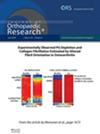Synovial Dysregulation in Ankle Osteoarthritis: Molecular Insights and Pathogenetic Pathways
Abstract
Osteoarthritis of the ankle is a debilitating condition affecting nearly 20% of adults in the United States. The tissue, cellular, and molecular basis of this disease remains poorly understood, particularly the role of the synovial membrane. This prospective case-control study examined the gene expression profile of synovial tissue in ankle osteoarthritis to uncover biological pathways altered in the disease. Synovial biopsies were obtained from twenty-six patients with ankle osteoarthritis undergoing joint replacement and eight patients with minimal or no evidence of osteoarthritis. Bulk RNA-sequencing and differential gene expression analysis were performed, followed by biological pathway enrichment, unsupervised cluster, and network-based analysis. Synovium from ankle osteoarthritis patients showed distinct gene expression patterns compared to controls, with enrichment in pathways related to extracellular matrix remodeling and tissue morphogenesis. Age and a prior history of ankle fracture were identified as significant factors influencing the transcriptomic profile of osteoarthritic synovium. After accounting for these variables, transcriptomic clustering perfectly distinguished osteoarthritic from non-osteoarthritic synovium and revealed upregulation of pathways involved in muscle development, neural signaling, immune response, and carbohydrate metabolism. Conversely, pathways related to ribosome production, protein synthesis, and cellular signaling were downregulated. Multiple WNT signaling pathways remained significantly enriched in osteoarthritic ankle synovium. This study identifies a distinct gene expression profile in the synovium of ankle osteoarthritis patients, highlighting key molecular pathways possibly involved in disease progression. These findings provide valuable insights into the molecular mechanisms driving ankle osteoarthritis and have the potential to inform the development of novel targeted therapeutic strategies.

 求助内容:
求助内容: 应助结果提醒方式:
应助结果提醒方式:


